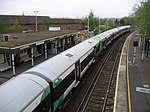Sackville College
1609 establishments in England1622 establishments in EnglandAlmshouses in West SussexBuildings and structures completed in 1622Buildings and structures in West Sussex ... and 4 more
East GrinsteadGrade I listed almshousesGrade I listed buildings in West SussexTourist attractions in West Sussex

Sackville College is a Jacobean almshouse in town of East Grinstead, West Sussex, England. It was founded in 1609 with money left by Robert Sackville, 2nd Earl of Dorset. Throughout its history it has provided sheltered accommodation for the elderly.
Excerpt from the Wikipedia article Sackville College (License: CC BY-SA 3.0, Authors, Images).Sackville College
High Street, Mid Sussex Sunnyside
Geographical coordinates (GPS) Address Nearby Places Show on map
Geographical coordinates (GPS)
| Latitude | Longitude |
|---|---|
| N 51.1246 ° | E -0.0041 ° |
Address
High Street
RH19 3BX Mid Sussex, Sunnyside
England, United Kingdom
Open on Google Maps








